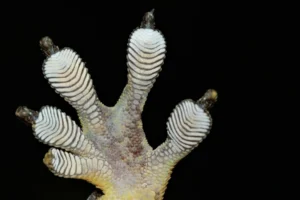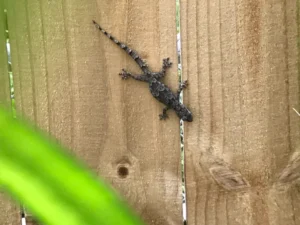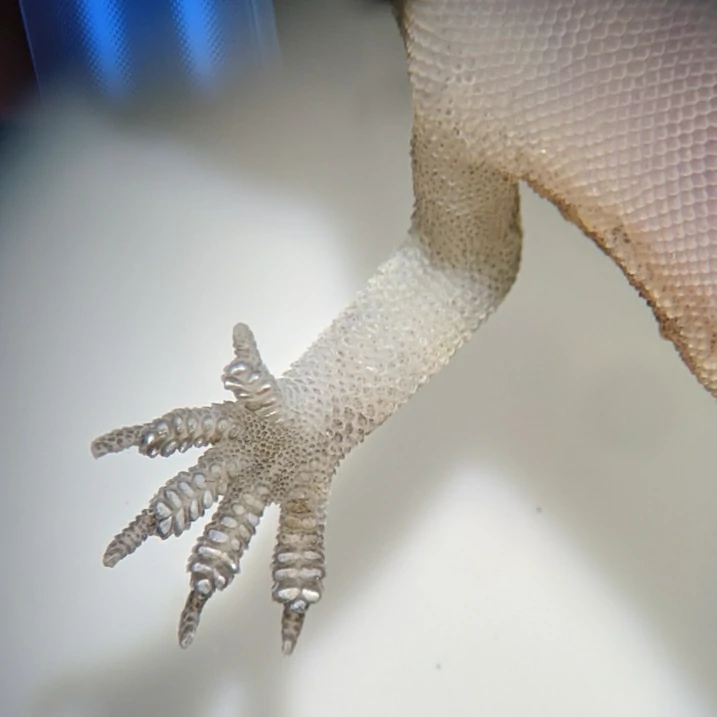If you’ve ever watched a gecko cling upside down on glass or run straight up a wall, you probably thought, how do those tiny feet do that? It looks like magic, but it’s really a mix of how their toes are built, how they grip, and how they’ve evolved over time. So, how many toes do geckos actually have, and what makes them so good at climbing?
Most geckos have five toes on each foot, but not every gecko is built the same. Some have fewer toes or smaller toe pads depending on where they live and when they are active. The trick isn’t just the number of toes, it’s what’s on them that really matters.
Five Toes, But Not Always the Same
Let’s keep it simple. Most geckos (from the little house gecko on your wall to the leopard gecko in your terrarium) have five toes on each foot. That adds up to 20 toes total.
Each toe helps them balance and move around. But the shape, size, and stickiness of those toes changes depending on what they need in their environment to survive.
For example, Tokay geckos have wide, sticky toes that let them climb smooth walls in humid forests. Leopard geckos have dry, clawed toes that are better for running across sand and rocks.
So yes, both have five toes, but how those toes are built makes a huge difference in how they live.
What Makes Gecko Toes So Sticky?
You’ve probably heard geckos can stick to almost anything, even glass or ceilings. It’s not glue or suction cups. It’s tiny physics doing its thing.
Each gecko toe is covered in millions of microscopic hairs called setae. Each of those hairs splits into even smaller tips called spatulae.

Those tips are so tiny they grab onto the molecules of a surface using a weak force called van der Waals forces.
In plain words:
-
Setae = tiny hairs on their toes
-
Spatulae = even tinier ends that grab surfaces
-
Result = a grip that’s strong but easy to lift when they need to
When a gecko walks, it presses its toes down to stick, then curls them up to peel off quickly. That’s how they can run across a ceiling without falling.
Do All Geckos Have the Same Kind of Toes?
Not at all. Some geckos are sticky climbers, while others live mostly on the ground and don’t need that skill.
Take these examples:
-
Crested geckos and day geckos have big toe pads for gripping leaves, glass, or tree trunks
-
Leopard geckos and fat-tailed geckos don’t have sticky pads, they use claws instead
-
Desert geckos have thinner toes so they can walk lightly over loose sand
Toe design isn’t one-size-fits-all. It’s just nature helping each gecko live the way it needs to.
How Geckos Use Their Toes in the Wild
Gecko toes aren’t just for sticking or walking. They’re tools that help geckos survive.
When a house gecko hunts at night, its toes help it stay still on vertical walls while waiting for insects. In the rainforest, day geckos use sticky toes to leap between branches and land without slipping.

Even geckos without sticky pads, like leopard geckos, rely on their toes for balance and speed. Their claws help them dig burrows or chase crickets across rocks.
Every move (running, climbing, stopping fast) depends on how their toes touch the surfaces around them.
Why Do Some Geckos Lose Toes or Toepads?
Sometimes you’ll see a gecko missing a toe or two. This can happen for a few reasons: shedding problems, injuries, or fights with other geckos.
When a gecko sheds, the skin around its toes needs to come off cleanly. If the humidity is too low, old skin can get stuck and cut off blood flow, causing the tip of a toe to die and fall off.
That’s why keeping proper humidity and hydration is very important if you’re keeping geckos. Healthy toes stay flexible and keep their grip strong.
Can Gecko Toes Regrow?
Unlike tails, gecko toes don’t grow back once lost. The area may heal, but the tiny hairs and pads won’t come back.
If a gecko loses a toe, it learns to balance differently and uses its other toes more. Still, losing a toe can change how it climbs, especially for species that really rely on sticky pads.
How Do Gecko Toes Compare to Other Lizards?
Geckos are part of a bigger group of lizards, but they stand out for their sticky toes. Other climbing lizards, like anoles, have sticky toes too, but they work differently.

Geckos’ toes are so advanced that engineers study them to make sticky materials inspired by geckos. Some labs even made “gecko tape” that can stick to walls and hold heavy objects without glue.
So gecko toes don’t just help geckos, they’ve inspired human technology too.
Do Gecko Toes Work on Every Surface?
Almost, but not every surface. Smooth, clean surfaces like glass or leaves are perfect. Dusty, wet, or oily surfaces can make them slip.
For example, a gecko might slide a little on a fogged window or dusty wall. Dirt and moisture get in the way of the tiny hairs grabbing the surface.
Still, they clean themselves quickly. A step or two later, their toes are ready to grip again. It’s one of nature’s smartest designs.
How Geckos Keep Their Toes Clean
Even cooler, gecko toes clean themselves naturally.
Scientists found that as geckos walk, dirt falls off the tiny hairs. The shape of their toe pads makes sure dust doesn’t stick for long.
It’s like having a built-in cleaning system. That’s why they can keep climbing easily, even in dusty areas.
How Baby Geckos Use Their Toes From Day One
When baby geckos hatch, their toes already work. They can climb a glass wall within hours of hatching.
This helps them survive right away. They can escape predators, explore, and hunt small insects. For ground-dwelling geckos, the toes help with balance and digging too.
It’s why geckos are so independent after birth.
What Happens When a Gecko Walks Upside Down?
Walking upside down looks impossible, but geckos do it with perfect timing.
Each toe lifts and sticks in a pattern that keeps them steady. The front toes peel off backward while the back ones move forward, creating a smooth wave-like motion.

They even change the angle of their toes depending on the surface. On walls, they spread them wide. On ceilings, they curl them slightly. Their brains and muscles handle all this automatically.
Do Geckos Need All Five Toes to Climb?
Not always. Some species with fewer toes, like desert geckos, can still climb short surfaces using claws and friction.
But species with sticky pads need most of their toes to balance forces that stop them from falling. Lose too many, and climbing vertical surfaces becomes harder.
So one missing toe isn’t the end of the world, but having all five keeps their grip strong.
Conclusion
So, how many toes do geckos have? Most have five on each foot, but it’s not the number that makes them special; it’s how those toes are built and used.
From the sticky hairs that let them walk upside down to the self-cleaning pads that keep them quick and light, gecko toes are tiny miracles of natural design.
Next time you see one clinging to your wall, remember, it’s not magic. It’s millions of microscopic hairs, years of adaptation, and perfect design working quietly together.
Hi, my name is Ezra Mushala, i have been interested animals all my life. I am the main author and editor here at snakeinformer.com.

